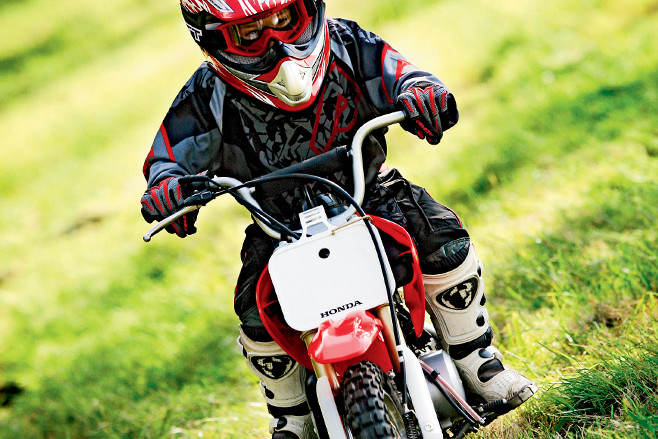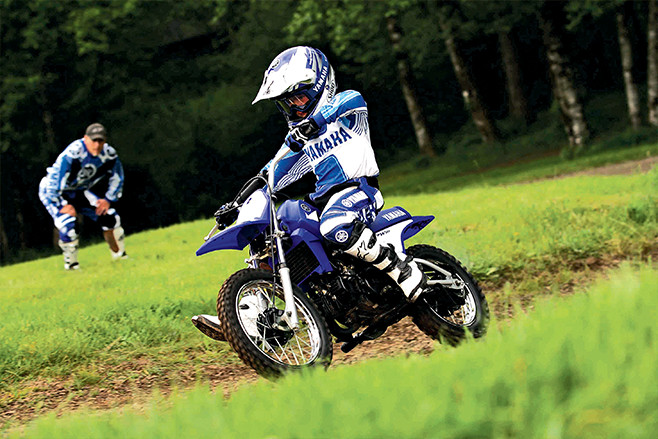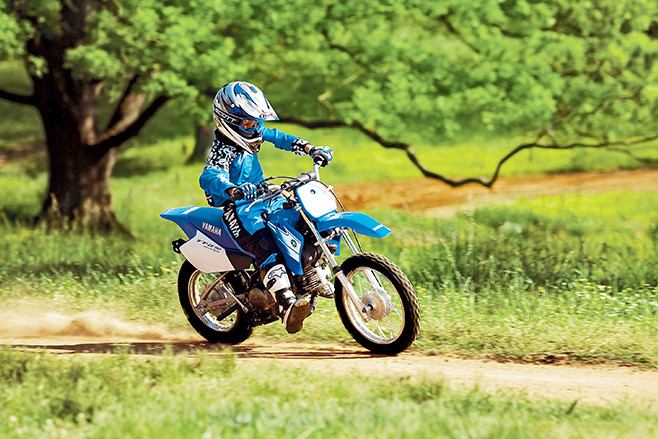If you come from a family of riders you’ll find most kids love the idea of getting on a bike – yours or their own, and for many children, their introduction to motorcycling is hopping on a bike behind a parent and going for a little ride around the yard.
First note of caution: If you start your kids’ love of riding with a dink around the yard, put a helmet on the little tacker.
On the back | Pillion
In most, if not all states, kids must be eight or older to ride pillion, and must be able to reach a set of footpegs with their feet. They’re also required to wear (at a minimum) an approved motorcycle helmet. The exception is younger kids, who can be carried in a sidecar, but they too are required to wear a motorcycle helmet.
It’s recommend to get the tykes decent riding gear, particularly if he or she is going to spend any significant time on the back, such as joining you on a long road trip. Most motorcycle accessory stores stock smaller sizes for children, though road gear can be more challenging to find than off-road gear for smaller people. You may well find yourself adapting some off-road gear to suit road use.

As for the bike, good pillion grab handles are essential, and things get a whole lot more comfortable for them if they have a well-equipped rear throne, with a backrest. It makes them less weary and susceptible to little surprises.
Keep in mind the needs of kids may well be different to yours. Their attention span is often shorter and the need for sleep and/or exercise more urgent. Years of carrying my daughters on long trips taught me a few things. For example, give them some control over the plot, such as when you pull up for a rest, and even allow them to have some say in which route you take. If they feel they’re contributing and have something to look forward to, they’ll be a whole lot happier. Remember, a happy pillion means a happy rider.
On the front | Pilot
Children do ride from a very young age – three to four years old is surprisingly common. There’s no hard and fast rule, but if they can ride a bicycle without training wheels, they can probably manage a minibike as well.
Once your child starts riding solo, the riding clobber really becomes critical. If you start them early with the correct gear, they’ll be comfortable with wearing it for the rest of their lives. There’s no substitute for going to a real shop and buying real clothing from someone who actually knows the equipment. Online shopping has its uses, but this isn’t one of them.
I’m a fan of hunting down the lightest helmet possible, to reduce the possibility of neck injury. Similarly, riding gear needs to be flexible enough to actually operate the bike. Having a kid suited up like a shop dummy does look funny, but if they can’t move easily, they won’t be able to ride properly.
If you start them early with the correct gear, they’ll be comfortable with wearing it for the rest of their lives.
Also, keep an eye out for signs of dehydration and heat stress – both can creep up on little ones without much warning.
Assuming you have a kid-friendly bike (it needs to be small enough for them to put both feet on the ground comfortably), you really need to be sure you brief them properly.
Lesson one – and the only thing they need to remember – is how to pull the damned thing to a stop. I’ve seen kids walk away from riding because they have freaked out on the first attempt when the bike has bolted at high speed with them on board.
Keep in mind that the natural response to a motorcycle accelerating is for the body to tilt back and for the straightened arm to wind on the throttle, making the situation worse. You need to give junior a heads-up (find a motorcycle trainer if you can – they’re not all that expensive) and, most importantly, have that first ride somewhere nice and open. Believe me, if they see an obstacle they’ll get fixated and clout it.

Now before you go too far down this road, just keep in mind that motorcycling can turn into an ongoing commitment – unless your son or daughter takes up mountaineering or windsurfing, leaving you stuck with a shed of unwanted motorcycles and gear – the commitment will include having to change the clothing and the bike on a regular basis. This is because the little ones grow at an alarming rate, especially when they learn how to open the fridge.
Plus, you need somewhere for them to ride. And that, for many, is by far the biggest hurdle. Unlicenced riders have incredibly limited options and this is where getting to know your local club will be invaluable. National parks and public land are generally not available, and even private property can be problematic.
So, a trailer and access to the nearest track is likely to become essential. The good news is most community-owned tracks have a range of other facilities which make life easier, including a bunch of social activities and coaching sessions.
One of the best places to trace your local club is via the state-based Motorcycling Australia affiliates (see the list). Their listings generally give a brief description of what each club covers, which is a good starting point.
Our sister mag, Australasian Dirt Bike, publishes a national list of off-road tracks and clubs, which is well worth getting your hands on.
Once you do find somewhere to exercise the toys, you’ll discover the joys of riding with the young ’uns. It is great fun and, despite the physical risks which always need to be considered, it’s a whole lot better for them than many of the alternatives, like sitting at home in front of a computer screen.
The biggest casualty is likely to be your ego, when you discover the little buggers can ride better than you. At that point all of your motorcycles become theirs!/em>
Getting a minibike
While it’s tempting to buy the cheapest bike you can find, the rash of ultra-cheap imports has comprehensively demonstrated that they can be a false economy. Cheap products are manufactured to a price point.
The price of a basic 50cc minibike from one of the major makers – such as Honda, Yamaha, Suzuki and Kawasaki – starts a little under $2000, which is somewhat eye-watering. However, a reasonably well cared-for one will be a cinch to resell (particularly in the lead-up to Christmas) and you’ll get most of your money back.
Entry-level models tend to be semi or fully auto and sometimes have an adjustable restrictor, so you can alter how much power is available until the kid gets up to speed.
Entry-level models are easy to look after. Frequent oil changes, the odd chain lube and session with a set of spanners to check adjustments is all they require. As the rider gets bigger and better, the choice become more expensive and complex. One big decision will be whether you need a race-oriented machine or a more easy-going trail riding option.
The big issue with these things tends to be maintenance, because as junior moves on to the next toy you’ve got other things to worry about. But getting into a post-ride routine will ensure the bike is ready for the next outing. It will also helps maintain its resale value.

Competition bodies | Useful club lists and locations
NSW & ACT
NT
Qld
SA
Tas
Vic
WA
National











